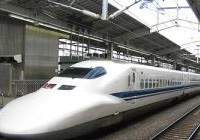Kyoto Japan
Kyoto was Japan's capital and the Emperor's residence from 794 until 1868. This 1200 year old city, Japan's fifth largest, is the cultural epicenter of the country and was home to imperial rulers for more than a thousand years.
Over the centuries, Kyoto was destroyed by many wars and fires; due to its historic value, it may be why the city was spared as a target of air raids during World War II.
Kyoto has more than 2,000 Shinto Shrines and Buddist Temples and 14 World Heritage sites, as well as palaces and gardens. Nowhere will you find more cultural and historical excellence than in Kyoto.
Around Kyoto Station
The southern ward of Shimogyo-ku, which stretches from Kyoto Station north to Shijo Dori Avenue, caters to tourists with its cluster of hotels and to commuters with its shops and restaurants. Kyoto Station, which caused quite a controversy when built because of its size, height, and futuristic appearance, is now this area's top attraction with Isetan department store, a shopping arcade, restaurants, a cinema, a theater, and dramatic public spaces, including a rooftop plaza.
Eastern Kyoto
East of the Kamo River, the wards of Higashiosaka and Sakyo-ku boast a number of the city's most famous temples and shrines, as well as restaurants specializing in Kyoto cuisine and Buddhist vegetarian dishes, and shops selling local pottery and other crafts. Eastern Kyoto is a great area for walking and shopping, particularly Higashiyama-ku, and boasts several ryokan as well. Gion, Kyoto's most famous geisha entertainment district, is part of Higashiyama-ku. Customers are entertained in traditional wooden geisha houses that are not open to the public (you can only gain entry through introductions provided by someone who is already a customer) -- but the area makes for a fascinating stroll.
Click here for guided tours in Kyoto
Northern Kyoto
Embracing the Kita-ku, Kamigyo-ku, and Ukyo-ku wards, northern Kyoto is primarily residential but contains a number of Kyoto's top sights, including the Kyoto Imperial Palace, Kinkakuji (Temple of the Golden Pavilion), and Ryoanji Temple, site of Kyoto's most famous Zen rock garden.
Central Kyoto Nakagyo-ku
The central part of Kyoto west of the Kamo River and north of Shimogyo-ku, embraces Kyoto's main shopping and nightlife districts, with most of the action on Kawaramachi and Shijo Dori avenues and Teramachi and Shin-kyogoku covered shopping arcades. Most of Kyoto's legendary craft stores are located here, along with numerous restaurants and bars. Home also to Nijo Castle, Nakagyo-ku has a number of exclusive ryokan tucked away in delightful neighbourhoods typical of old Kyoto. But downtown is changing fast, as Kyoto's younger generation lays claim to new shopping and entertainment complexes, such as Shin-Puh-Kan, a renovated telephone company building on Karasuma Dori filled with shops and restaurants and an open stage for concerts. Nakagyo-ku is one of the most desirable places to stay in terms of convenience and atmosphere.
Pontocho a narrow lane that parallels the Kamo River's western bank just a stone's throw from the Kawaramachi-Shijo Dori intersection, is Kyoto's most famous street for nightlife. It's lined with bars and restaurants that boast outdoor verandas extending over the Kamo River in summer.




